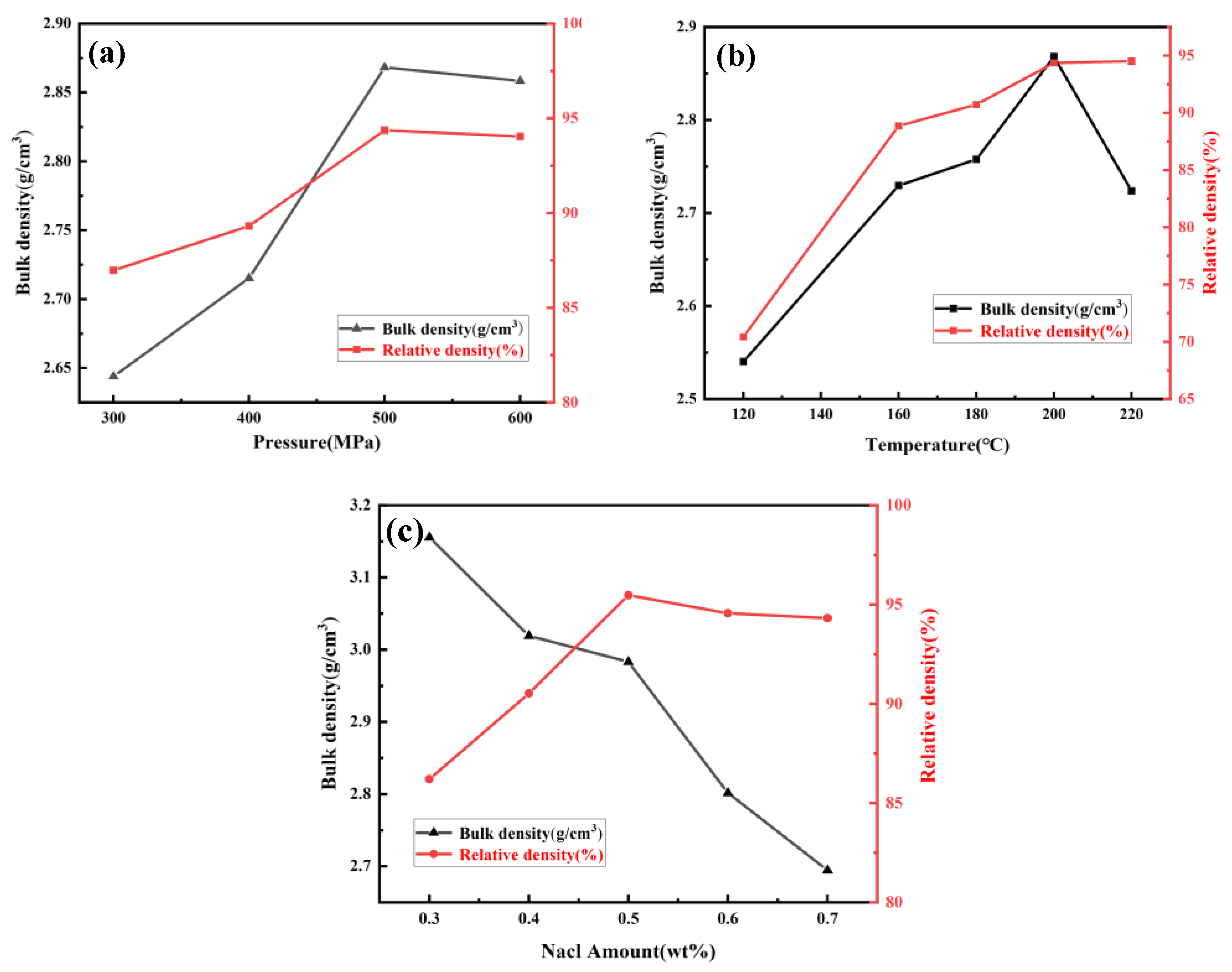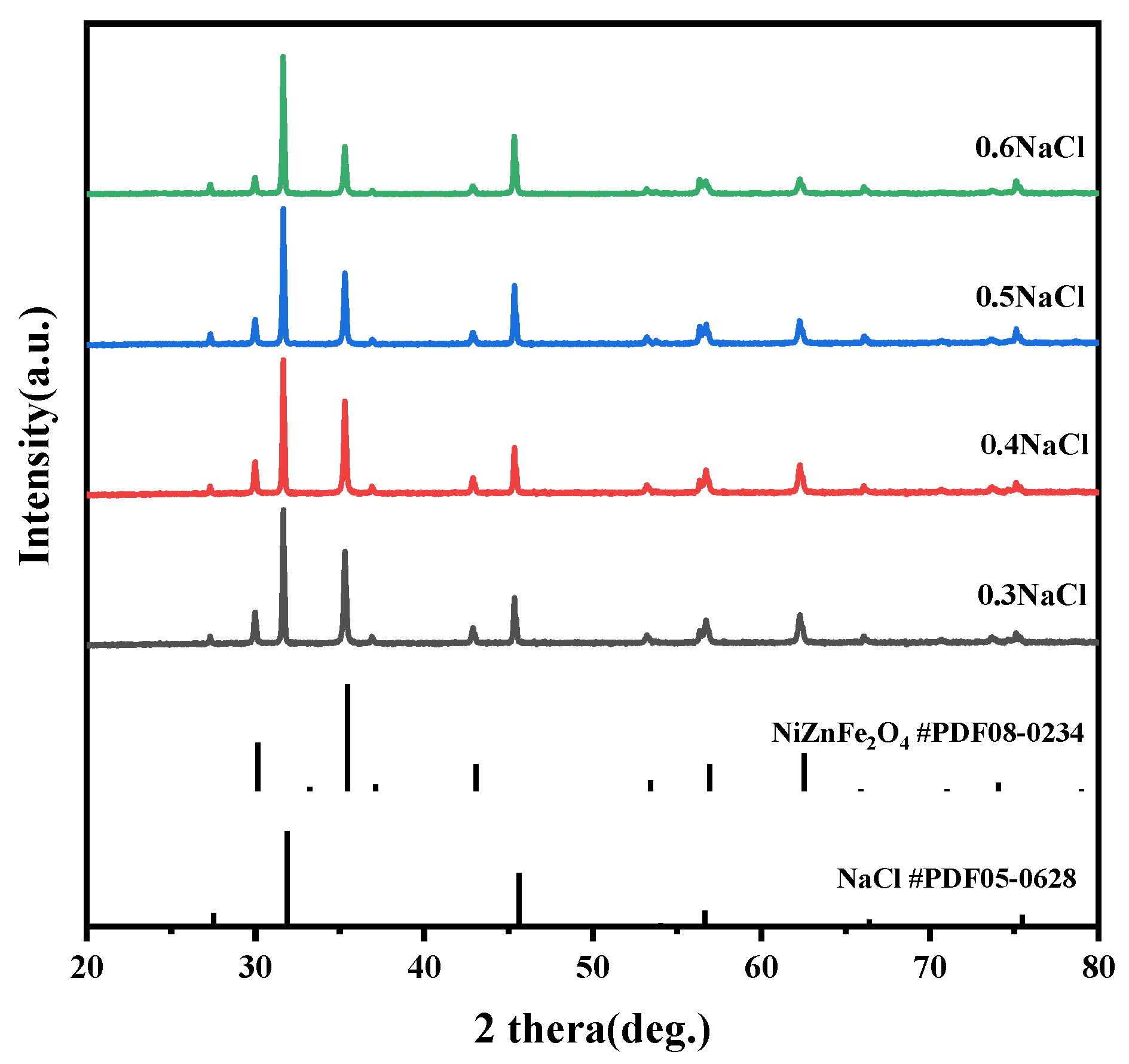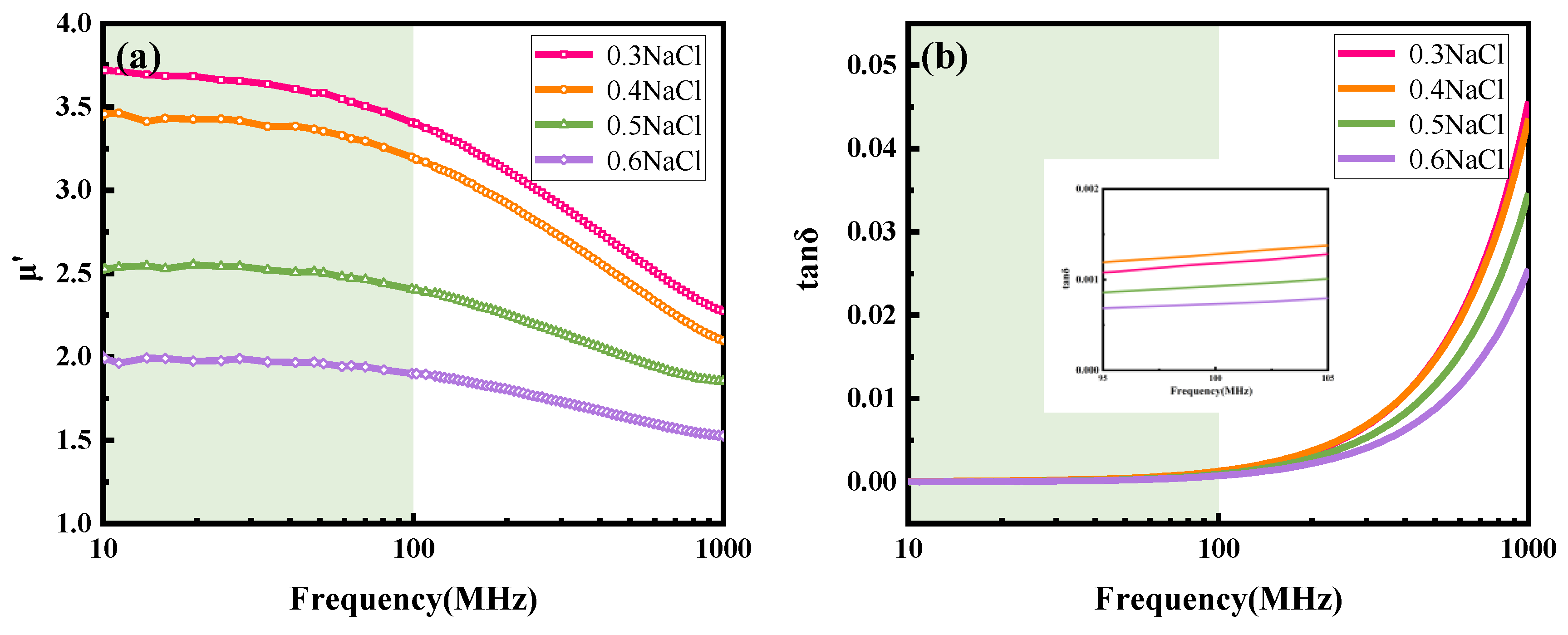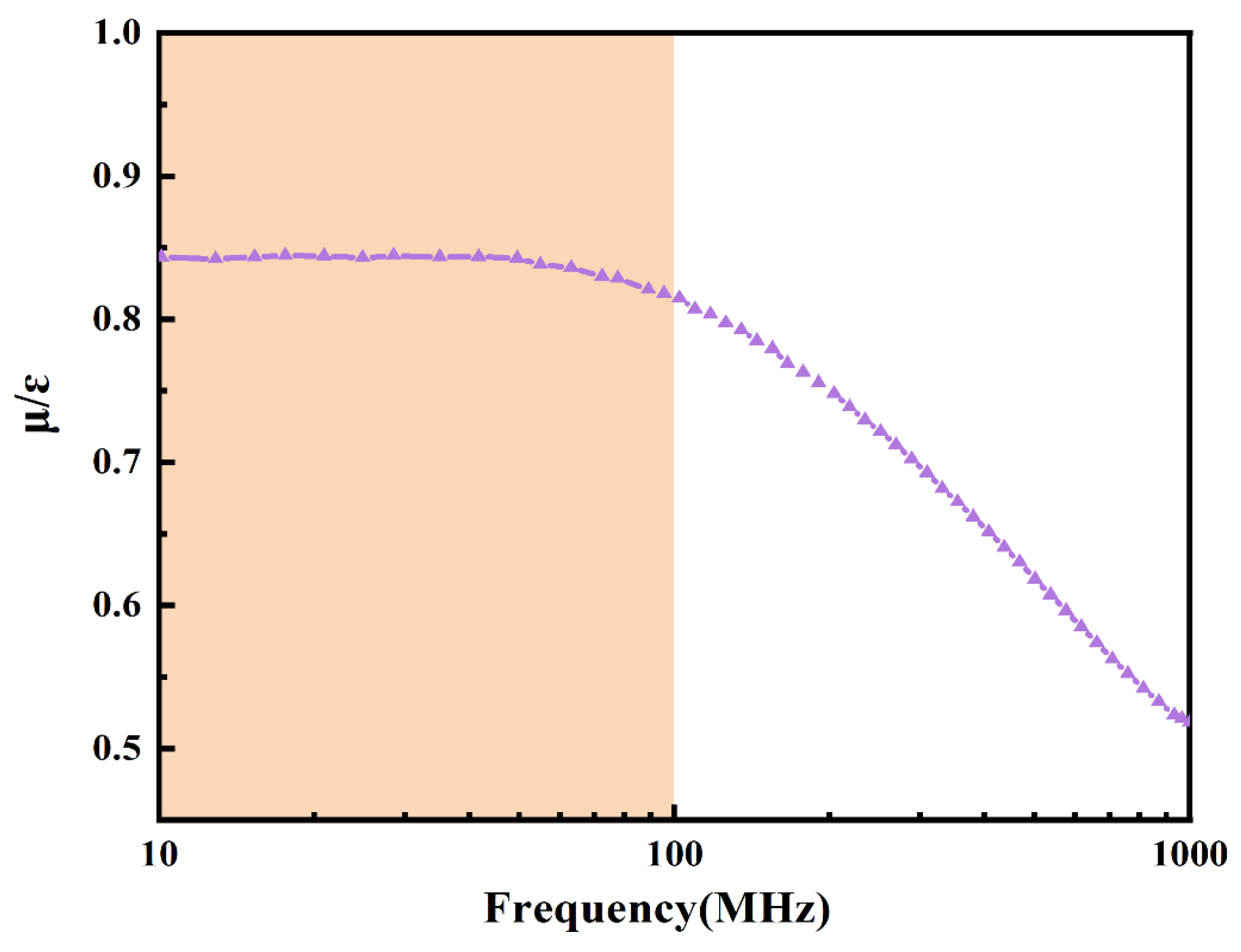Cold Sintering Isomagnetic Dielectric NaCl-Nickel Zinc Ferrite Composite Ceramics
Abstract
1. Introduction
2. Experimental Procedure
3. Results and Analysis
4. Conclusions
Supplementary Materials
Author Contributions
Funding
Data Availability Statement
Acknowledgments
Conflicts of Interest
References
- Li, Y.J.; Chen, X.M.; Hou, R.Z.; Tang, Y.H. Maxwell–Wagner characterization of dielectric relaxation in Ni0.8Zn0.2Fe2O4/Sr0.5Ba0.5Nb2O6 composite. Solid State Commun. 2006, 137, 120–125. [Google Scholar] [CrossRef]
- Zhou, M.F.; Hu, C.C.; Yin, J.B.; Jiang, Y.; Liu, B.; Song, K.X. Cold sintering optimized SrF2 microwave dielectric ceramics for the development of dielectric resonator antenna at 5G millimeter-wave band. Ceram. Int. 2022, 48, 29847–29853. [Google Scholar] [CrossRef]
- Ji, Y.; Song, K.; Zhang, S.; Lu, Z.; Wang, G.; Li, L.; Zhou, D.; Wang, D.; Reaney, I.M. Cold sintered, temperature-stable CaSnSiO5-K2MoO4 composite microwave ceramics and its prototype microstrip patch antenna. J. Eur. Ceram. Soc. 2021, 41, 424–429. [Google Scholar] [CrossRef]
- Rajan, A.; Solaman, S.K.; Ganesanpotti, S. Cold sintering: An energy-efficient process for the development of SrFe12O19–Li2MoO4 composite-based wide-bandwidth ferrite resonator antenna for Ku-band applications. ACS Appl. Electron. Mater. 2021, 3, 2297–2308. [Google Scholar] [CrossRef]
- El-Shater, R.E.; Atlam, A.S.; Elnimr, M.K.; Assar, S.T.; Tishkevich, D.I.; Zubar, T.I.; Trukhanov, S.V.; Trukhanov, A.V.; Zhou, D.; Darwish, M.A. AC measurements, impedance spectroscopy analysis, and magnetic properties of Ni0.5Zn0.5Fe2O4/BaTiO3 multiferroic composites. Mater. Sci. Eng. B 2022, 286, 116025. [Google Scholar] [CrossRef]
- Zubairi, H.; Hussain, F.; Sheikh, S.; Shaikh, A.A.; Wang, D.; Reaney, I.M. Comparative study of cold assisted and conventional sintering of (1-2x)K0.5Na0.5NbO3-xBaTiO3-xBiFeO3 multiferroic ceramics. Mater. Sci. Eng. B 2023, 296, 116632. [Google Scholar] [CrossRef]
- Chi, M.; Liu, Y.; Zhao, J.; Dong, C.; Luo, X.; Wang, D.; Liu, B.; Mao, M.; Shi, F.; Song, K. Mg3B2O6 microwave dielectric ceramics fabricated by combining cold sintering with post-annealing process. J. Am. Ceram. Soc. 2022, 106, 285–292. [Google Scholar] [CrossRef]
- Zhang, H.-W.; Shi, Y.; Zhong, Z.-Y. Electric and magnetic properties of a new ferrite-ceramic composite material. Chin. Phys. Lett. 2002, 19, 269–272. [Google Scholar]
- Zhang, H.; Zhong, H.; Liu, B.; Jing, Y.; Liu, Y. Electromagnetic properties of a new ferrite-ceramic low-temperature cocalcined (LTCC) composite materials. IEEE Trans. Magn. 2005, 41, 3454–3456. [Google Scholar] [CrossRef]
- Zhong, H.; Zhang, H. Synthesis and electromagnetic properties of ferroelectric–ferromagnetic composite material. J. Magn. Magn. Mater. 2004, 288, 74–78. [Google Scholar] [CrossRef]
- Ling, W.; Zhang, H.; Song, Y.; Liu, Y.; Li, Y.; Su, H. Low-temperature sintering and electromagnetic properties of ferroelectric–ferromagnetic composites. J. Magn. Magn. Mater. 2009, 321, 2871–2876. [Google Scholar] [CrossRef]
- He, Y.; Zhang, H.; Wang, Y.; Ling, W.; Mu, C.; Bai, F.; Liu, P. Electrical and magnetic properties of NiCuZn-CaCu3Ti4O12 composites doped with Bi2O3. J. Alloys Compd. 2010, 504, 435–439. [Google Scholar] [CrossRef]
- Yamamoto, T.; Chino, M.; Tanaka, R.; Ueyama, T.; Okazaki, K. Evaluation of ferroelectric/ferromagnetic composite by microcom-posite designing. Ferroelectrics 1989, 95, 175–178. [Google Scholar] [CrossRef]
- Goglio, G.; Ndayishimiye, A.; Elissalde, C.; Randall, C. Cold Sintering and Hydrothermal Sintering. Encycl. Mater. Technol. Ceram. Glas. 2021, 1, 311–326. [Google Scholar]
- Induja, I.J.; Sebastian, M.T. Microwave dielectric properties of mineral sillimanite obtained by conventional and cold sintering process. J. Eur. Ceram. Soc. 2017, 37, 2143–2147. [Google Scholar] [CrossRef]
- Bin Hong, W.; Li, L.; Yan, H.; Wu, S.Y.; Yang, H.S.; Chen, X.M. Room-temperature-densified H3BO3 microwave dielectric ceramics with ultra-low permittivity and ultra-high Qf value. J. Mater. 2020, 6, 233–239. [Google Scholar]
- Guo, J.; Berbano, S.S.; Guo, H.; Baker, A.L.; Lanagan, M.T.; Randall, C.A. Cold Sintering Process of Composites: Bridging the Processing Temperature Gap of Ceramic and Polymer Materials. Adv. Funct. Mater. 2016, 26, 7115–7121. [Google Scholar] [CrossRef]
- Guo, J.; Guo, H.; Baker, A.L.; Lanagan, M.T.; Kupp, E.R.; Messing, G.L.; Randall, C.A. Cold sintering: A paradigm shift for processing and integration of ceramics. Angew. Chem. Int. Ed. 2016, 55, 11457–11461. [Google Scholar] [CrossRef]
- Guo, J.; Baker, A.L.; Guo, H.; Lanagan, M.; Randall, C.A. Cold sintering process: A new era for ceramic packaging and microwavedevice development. J. Am. Ceram. Soc. 2017, 100, 669–677. [Google Scholar] [CrossRef]
- Santha, N.; Rakhi, M.; Subodh, G. Fabrication of high quality factor cold sintered MgTiO3–NaCl microwave ceramic composites. Mater. Chem. Phys. 2020, 255, 123636. [Google Scholar] [CrossRef]
- Ndayishimiye, A.; Sengul, M.Y.; Bang, S.H.; Tsuji, K.; Takashima, K.; de Beauvoir, T.H.; Denux, D.; Thibaud, J.-M.; van Duin, A.C.; Elissalde, C.; et al. Comparing hydrothermal sintering and cold sintering process: Mechanisms, microstructure, kinetics and chemistry. J. Eur. Ceram. Soc. 2019, 40, 1312–1324. [Google Scholar] [CrossRef]
- Guo, J.; Zhao, X.; De Beauvoir, T.H.; Seo, J.-H.; Berbano, S.S.; Baker, A.L.; Azina, C.; Randall, C.A. Recent Progress in Applications of the Cold Sintering Process for Ceramic–Polymer Composites. Adv. Funct. Mater. 2018, 28, 1801724. [Google Scholar] [CrossRef]
- Chen, N.; Xiao, B.; Xu, X.; Sun, T.; Chen, M.; Hu, R.; Deng, X.; Chen, X.; Wang, H. Cold-sintered Ni0.2Cu0.2Zn0.6Fe2O4-Li2MoO4 ceramic composites with enhanced magnetodielectric properties. J. Eur. Ceram. Soc. 2021, 41, 1310–1316. [Google Scholar] [CrossRef]
- Imran, Z.; Rafiq, M.A.; Hasan, M.M. Charge carrier transport mechanisms in perovskite CdTiO3 fibers. AIP Adv. 2014, 4, 13. [Google Scholar] [CrossRef]
- Yang, H.; Wang, H.; Xiang, F.; Yao, X. Microstructure and electromagnetic properties of SrTiO3/Ni0.8Zn0.2Fe2O4 composites by hybrid process. J. Am. Ceram. Soc. 2019, 92, 2005–2010. [Google Scholar] [CrossRef]
- Chi, M.; Liu, Y.; Zhou, T.; Mao, M.; Liu, B.; Wang, G.; Song, K. Ni doping improving magnesium borate microwave dielectric ceramic for LTCC via cold sintering and post-annealing process. J. Mater. Sci. Mater. Electron. 2023, 34, 235. [Google Scholar] [CrossRef]
- Sebastian, M.T.; Wang, H.; Jantunen, H. Low temperature co-fired ceramics with ultra-low sintering temperature: A review. Curr. Opin. Solid State Mater. Sci. 2016, 20, 151–170. [Google Scholar] [CrossRef]
- Li, C.; Liu, Y.; Chi, M.; Luo, X.; Liu, B.; Mao, M.; Bafrooei, H.B.; Wang, G.; Taheri-Nassaj, E.; Song, K. ULTCC post-annealing cold sintering densification process, microwave dielectric properties of Zn3B2O6 ceramics. Mater. Today Commun. 2022, 33, 104997. [Google Scholar] [CrossRef]
- Noh, B.I.; Yang, S.C. Ferromagnetic, ferroelectric, and magnetoelectric properties in individual nanotube-based magnetoelectric films of CoFe2O4/ BaTiO3 using electrically resistive core-shell magnetostrictive nanoparticles. J. Alloys Compd. 2022, 891, 161861. [Google Scholar] [CrossRef]
- Patil, A.D.; Pawar, R.A.; Patange, S.M.; Jadhav, S.S.; Gore, S.K.; Shirsath, S.E.; Meena, S.S. TiO2-doped Ni0.4Cu0.3Zn0.3Fe2O4 nanoparticles for enhanced structural and magnetic properties. ACS Omega 2021, 6, 17931–17940. [Google Scholar] [CrossRef]
- Samad, R.; Hassan, N.; Want, B. Magnetodielectric effect in rare earth doped BaTiO3-CoFe2O4 multiferroic composites. J. Alloys Compd. 2019, 794, 402–416. [Google Scholar]
- Mendelson, M.I. Average Grain Size in Polycrystalline Ceramics. J. Am. Ceram. Soc. 1969, 52, 443–446. [Google Scholar] [CrossRef]
- Li, J.; Wen, D.; Li, Q.; Qiu, T.; Gan, G.; Zhang, H. Equal permeability and permittivity in a low temperature co-fired In-doped Mg-Cd ferrite. Ceram. Int. 2018, 44, 678–682. [Google Scholar] [CrossRef]
- Peng, Y.; Wu, X.; Chen, Z.; Liu, W.; Wang, F.; Wang, X.; Feng, Z.; Chen, Y.; Harris, V.G. BiFeO3 tailored low loss M-type hexaferrite composites having equivalent permeability and permittivity for very high frequency applications. J. Alloys Compd. 2015, 630, 48–53. [Google Scholar] [CrossRef]
- Zahir, R.; Chowdhury, F.U.Z.; Uddin, M.M.; Hakim, M.A. Structural, magnetic and electrical characterization of Cd-substituted Mg ferrites synthesized by double sintering technique. J. Magn. Magn. Mater. 2016, 410, 55–62. [Google Scholar] [CrossRef]
- Lee, J.; Hong, Y.K.; Lee, W.; Abo, G.S.; Park, J.; Neveu, N.; Seong, W.M.; Park, S.H.; Ahn, W.K. Soft M-type hexaferrite for very high frequency miniature antenna applications. J. Appl. Phys. 2012, 111, 07A520. [Google Scholar] [CrossRef]
- Ishaque, M.; Khan, M.A.; Ali, I.; Khan, H.M.; Iqbal, M.A.; Islam, M.; Warsi, M.F. Investigations on structural, electrical and dielectric properties of yttrium substituted Mg-ferrites. Ceram. Int. 2015, 41, 4028–4034. [Google Scholar] [CrossRef]
- Yang, X.; Wang, X.; Huang, M.; Zhang, S.; Li, L. Synthesis and characterization of CaTiO3-(Sm, Nd)AlO3 microwave ceramics via sol-gel method. J. Sol-Gel Sci. Technol. 2014, 69, 61–66. [Google Scholar] [CrossRef]
- Shome, P.P.; Khan, T.; Koul, S.K.; Antar, Y.M. Two Decades of UWB Filter Technology: Advances and Emerging Challenges in the Design of UWB Bandpass Filters. IEEE Microw. Mag. 2021, 22, 32–51. [Google Scholar] [CrossRef]
- Du, M.; Li, L.; Yu, S.; Sun, Z.; Qiao, J. High-Q microwave ceramics of Li2TiO3 co-doped with magnesium and niobium. J. Am. Ceram. Soc. 2018, 101, 4066–4075. [Google Scholar] [CrossRef]
- Zhang, T.; Su, H.; Tang, X.; Zhang, H.; Jing, Y.; Liu, B. Low-Loss Composite NiCuZnCo-BaTiO3 with Matched Permeability and Permittivity in High Frequency Range. IEEE Trans. Magn. 2014, 50, 1–4. [Google Scholar] [CrossRef]
- Kong, L.B.; Li, Z.W.; Lin, G.Q.; Gan, Y.B. Mg1−xCoxFe1.98O4 Ceramics with Promising Magnetodielectric Properties for Antenna Miniaturization. IEEE Trans. Magn. 2008, 44, 559–565. [Google Scholar] [CrossRef]
- Su, H.; Tang, X.; Zhang, H.; Jing, Y.; Bai, F.; Zhong, Z. Low-loss NiCuZn ferrite with matching permeability and permittivity by two-step sintering process. J. Appl. Phys. 2013, 113, 17B301. [Google Scholar] [CrossRef]
- Kong, L.B.; Teo, M.L.S.; Li, Z.W.; Lin, G.Q.; Gan, Y.B. Development of magneto-dielectric materials based on Li-ferrite ceramics III. Complex relative permeability andmagneto-dielectric properties. J. Alloys Compd. 2008, 459, 576–582. [Google Scholar] [CrossRef]
- Thakur, A.; Chevalier, A.; Mattei, J.-L.; Queffélec, P. Low-loss spinel nanoferrite with matching permeability and permittivity in the ultrahigh frequency range. J. Appl. Phys. 2010, 108, 014301. [Google Scholar] [CrossRef]
- Xia, Q.; Su, H.; Shen, G.; Pan, T.; Zhang, T.; Zhang, H.; Tang, X. Investigation of low loss Z-type hexaferrites for antenna applications. J. Appl. Phys. 2012, 111, 063921. [Google Scholar] [CrossRef]
- Yang, Y.; Li, J.; Zhang, H.; Wang, G.; Rao, Y.; Gan, G. TiO2 tailored low loss NiCuZn ferrite ceramics having equivalent permeability and permittivity for miniaturized antenna. J. Magn. Magn. Mater. 2019, 487, 165318. [Google Scholar] [CrossRef]
- Wang, D.; Siame, B.; Zhang, S.; Wang, G.; Ju, X.; Li, J.; Lu, Z.; Vardaxoglou, Y.; Whittow, W.; Cadman, D.; et al. Direct Integration of Cold Sintered, Temperature-Stable Bi2Mo2O9-K2MoO4 Ceramics on Printed Circuit Boards for Satellite Navigation Antennas. J. Eur. Ceram. Soc. 2020, 40, 4029–4034. [Google Scholar] [CrossRef]








| Dielectric Constant | Frequency Range (MHz) | tanδε (max) | tanδμ (max) | S.T (°C) | Ref. | |
|---|---|---|---|---|---|---|
| Mg0.96Co0.04Fe1.98O4+ 3 wt% Bi2O3 | ~10 | 3–30 | 0.04 | 0.04 | 1000 | [42] |
| Ni0.855Cu0.1Zn0.025Co0.02Fe1.96O4 | ~11.8 | 10–100 | 0.015 | 0.015 | 950 | [43] |
| Li0.468Co0.032Fe2.484O4+ 3 wt% Bi2O3 | ~15 | 3–30 | 0.01 | 0.01 | 900 | [44] |
| Ni0.5Zn0.3Co0.2Fe2O4 | ~5 | 100–500 | 0.02 | 0.04 | 950 | [45] |
| (Ba0.5Sr0.5)3Co2Fe24O41+ 0.2 wt% WO3 | ~12 | 10–200 | 0.002 | 0.05 | 1200 | [46] |
| Ni0.368Cu0.2Zn0.432Fe1.96O3.94+ 12 wt% TiO2 | ~12 | 1–40 | 0.0004 | 0.023 | 950 | [47] |
| Ni0.35Co0.02Cu0.18Zn0.45Fe1.95O4 + 15 wt% BaTiO3 | ~28 | 3–30 | 0.002 | 0.02 | 1080 | [48] |
| 0.3H3BO3- 0.2NaCl-0.5Ni0.5Zn0.5Fe2O4 (this work) | ~6 | 10–100 | 0.036 | 0.001 | 200 |
Disclaimer/Publisher’s Note: The statements, opinions and data contained in all publications are solely those of the individual author(s) and contributor(s) and not of MDPI and/or the editor(s). MDPI and/or the editor(s) disclaim responsibility for any injury to people or property resulting from any ideas, methods, instructions or products referred to in the content. |
© 2023 by the authors. Licensee MDPI, Basel, Switzerland. This article is an open access article distributed under the terms and conditions of the Creative Commons Attribution (CC BY) license (https://creativecommons.org/licenses/by/4.0/).
Share and Cite
Han, J.; Chi, M.; Yang, L.; Liu, B.; Mao, M.; Bafrooei, H.B.; Ma, Z.; Ren, Y.; Shi, F.; Taheri-Nassaj, E.; et al. Cold Sintering Isomagnetic Dielectric NaCl-Nickel Zinc Ferrite Composite Ceramics. Crystals 2023, 13, 1140. https://doi.org/10.3390/cryst13071140
Han J, Chi M, Yang L, Liu B, Mao M, Bafrooei HB, Ma Z, Ren Y, Shi F, Taheri-Nassaj E, et al. Cold Sintering Isomagnetic Dielectric NaCl-Nickel Zinc Ferrite Composite Ceramics. Crystals. 2023; 13(7):1140. https://doi.org/10.3390/cryst13071140
Chicago/Turabian StyleHan, Jiuyuan, Mengjiao Chi, Liu Yang, Bing Liu, Minmin Mao, Hadi Barzegar Bafrooei, Zhongyan Ma, Yingjie Ren, Feng Shi, Ehsan Taheri-Nassaj, and et al. 2023. "Cold Sintering Isomagnetic Dielectric NaCl-Nickel Zinc Ferrite Composite Ceramics" Crystals 13, no. 7: 1140. https://doi.org/10.3390/cryst13071140
APA StyleHan, J., Chi, M., Yang, L., Liu, B., Mao, M., Bafrooei, H. B., Ma, Z., Ren, Y., Shi, F., Taheri-Nassaj, E., Wang, D., & Song, K. (2023). Cold Sintering Isomagnetic Dielectric NaCl-Nickel Zinc Ferrite Composite Ceramics. Crystals, 13(7), 1140. https://doi.org/10.3390/cryst13071140









